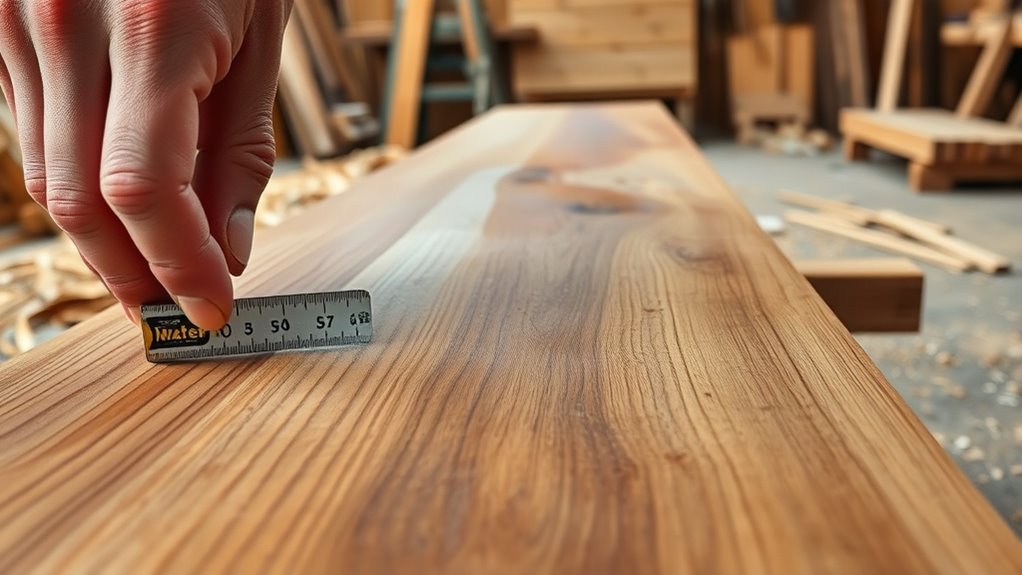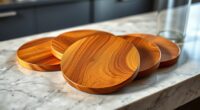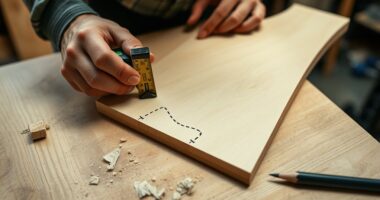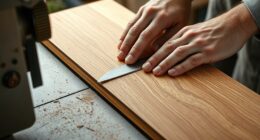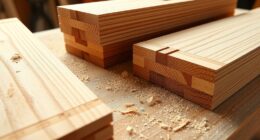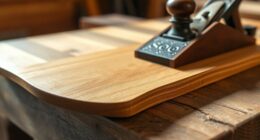To understand board foot measurements, you need to know that one board foot equals 144 cubic inches—think of a 1-foot by 1-foot by 1-inch thick piece of wood. To calculate, multiply width in inches, length in feet, and thickness in inches, then divide by 144. This helps guarantee you get the right amount of wood, avoid waste, and stay accurate. Keep going for detailed steps to master this essential woodworking skill.
Key Takeaways
- A board foot equals 144 cubic inches, simplifying volume measurement for lumber projects.
- Use the formula: (Width in inches × Length in feet × Thickness in inches) ÷ 12 to calculate board feet.
- Measure at multiple points to account for warping, tapering, or irregular shapes for accuracy.
- Convert nominal sizes to actual dimensions for precise volume estimation.
- Accurate board foot measurement ensures proper material planning, cost estimation, and reduces waste.
Understanding the Concept of a Board Foot
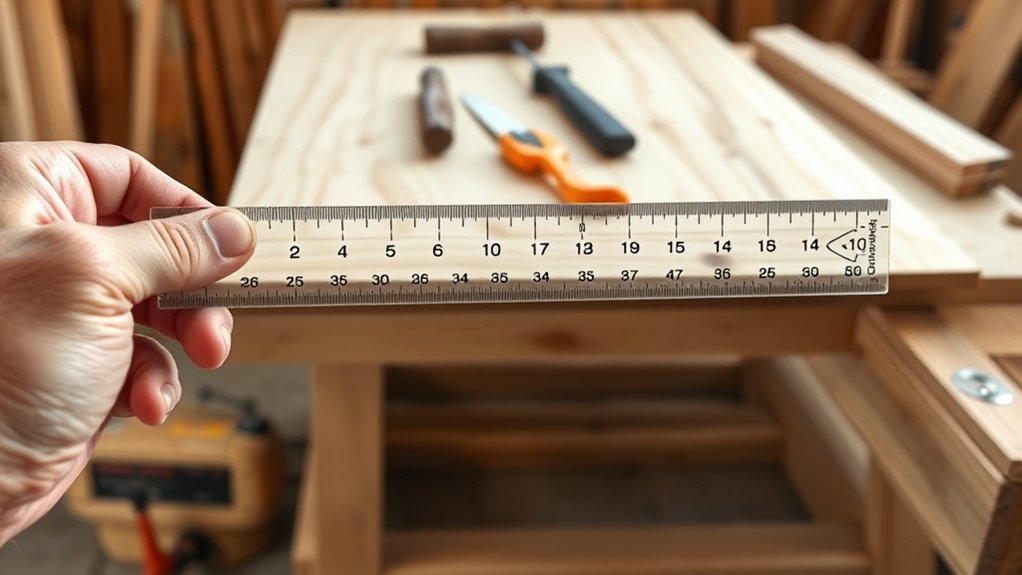
Have you ever wondered how lumber quantities are measured consistently across different projects? The answer lies in the concept of a board foot, a standard unit of measurement for wood volume. A board foot equals 144 cubic inches, representing a volume of 1 foot in length, 1 foot in width, and 1 inch thick. This measurement simplifies calculations and helps you compare different types of lumber regardless of species. To determine the number of board feet in a piece of wood, you multiply its dimensions—width, length, and thickness—and then divide by 144. Understanding measurement standards is crucial for accurate pricing, inventory, and project planning in woodworking and lumber industries. Being familiar with standard measurement units also helps you communicate effectively with suppliers and clients. This unit provides a clear and uniform way to communicate and understand wood volume, making it essential for accurate pricing, inventory, and project planning in woodworking and lumber industries.
Why Accurate Board Foot Estimation Is Essential

Accurate board foot estimation plays a essential role in managing your lumber resources effectively. When you have precise measurements, you can maintain proper inventory management, avoiding overstocking or shortages that delay your woodworking projects. Proper calculation of board feet helps with budgeting and cost control, ensuring you don’t overpay or underestimate your material needs. Reliable measurement accuracy reduces waste by optimizing the wood volume used, supporting sustainable practices. Correct estimations also guarantee you have enough material to complete your project without last-minute purchases, saving time and money. Additionally, accurate board foot calculations foster fair pricing and trustworthy transactions in lumber sales. Overall, mastering board foot estimation is important for efficient, cost-effective, and sustainable woodworking.
How to Calculate Board Feet Step-by-Step
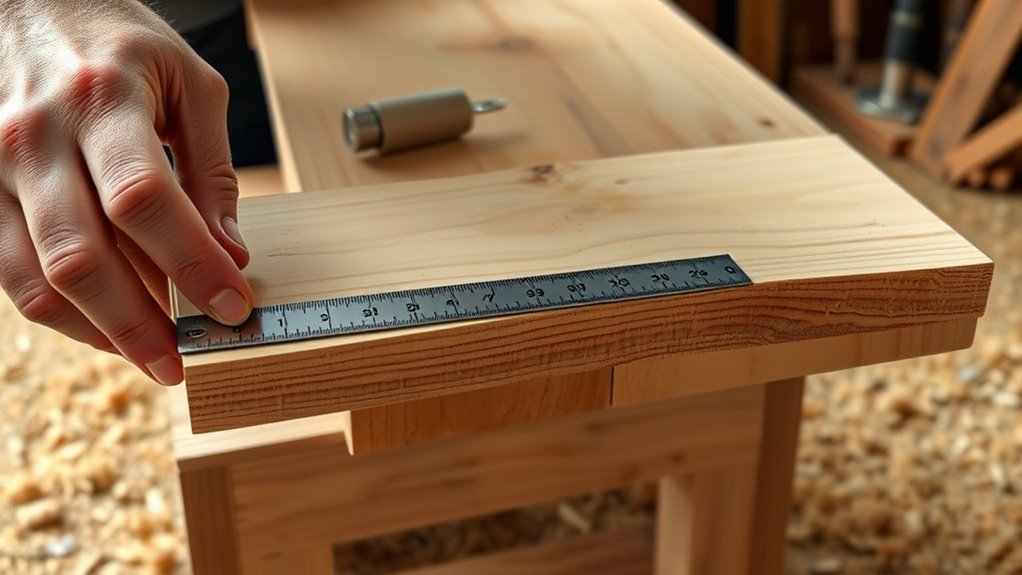
To calculate board feet accurately, you’ll need to use a straightforward formula that multiplies the lumber’s width in inches, its length in feet, and its thickness in inches, then divides the total by 144. First, measure the actual dimensions of your board—don’t rely on nominal sizes. Then apply the formula:
| Dimension | Measurement |
|---|---|
| Width | in inches |
| Length | in feet |
| Thickness | in inches |
For example, a board 6 inches wide, 8 feet long, and 1 inch thick calculates as (6 × 8 × 1) / 144 = 0.333 board feet. This method helps you accurately calculate your lumber’s volume, especially when considering space and organization in your woodworking or home improvement projects. Understanding measurement accuracy ensures precise calculations and efficient material usage for your projects, which is essential for cost management and project planning. Paying attention to wood grain orientation can also influence the final appearance and durability of your project. Additionally, being aware of retail hours can help you plan your shopping trips for supplies without inconvenience.
Common Challenges in Measuring Lumber Volume
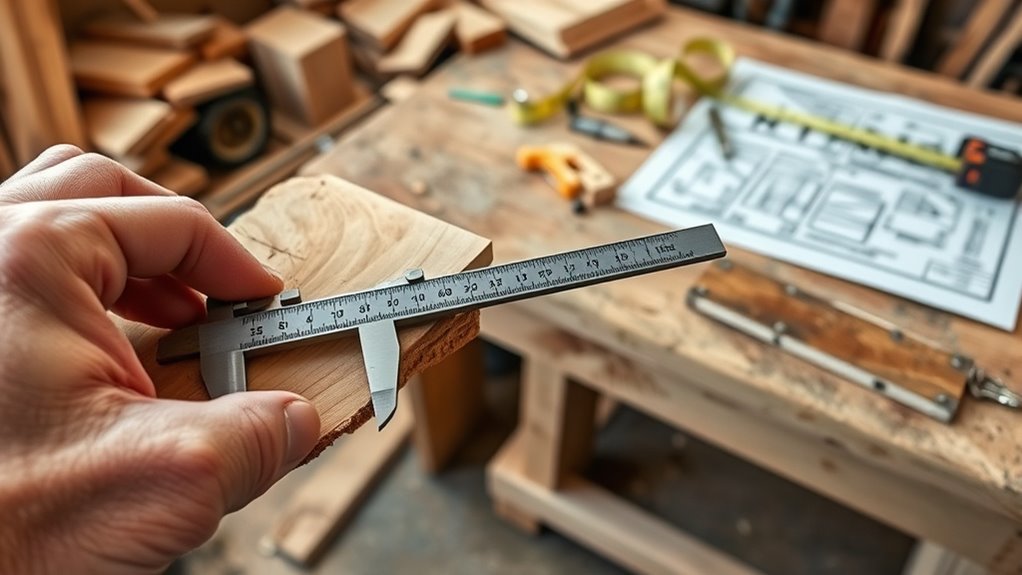
Measuring lumber volume can be tricky because standards vary, making it hard to get consistent results. Irregular shapes or defects in the wood can throw off your estimates if you don’t adjust measurements accordingly. Additionally, differences between nominal and actual dimensions, as well as changes during drying, add to the challenge of accurate measurement. Incorporating proper techniques from practices like measured poses in yoga can help improve your precision and understanding of spatial dimensions. Recognizing professional measurement standards can further enhance your accuracy in estimating lumber quantities. Being aware of cookie consent options can also help maintain your focus and privacy while researching woodworking techniques online.
Inconsistent Measurement Standards
Inconsistent measurement standards pose significant challenges when estimating lumber volume, especially across different markets and regions. Variations in measurement practices, such as industry measurement variations and differing measurement points, lead to lumber measurement inconsistencies. For example, the use of nominal vs actual size can cause confusion, as nominal dimensions don’t reflect the true, milled size. Additionally, measurement standards vary between the imperial units used in the U.S. and metric units preferred elsewhere, resulting in volume estimation discrepancies. Surface measure (SM) and different log rules further complicate accurate board foot calculation. These industry measurement variations make it difficult to compare or trust measurements, underscoring the importance of understanding measurement standards to achieve precise lumber volume estimates. Furthermore, measurement standards are crucial for ensuring consistency and accuracy across different regions and industries. Recognizing industry measurement variations helps woodworkers make better estimations and avoid costly errors. Additionally, understanding measurement conversion is essential when dealing with international or regional differences in lumber measurement practices. A clear grasp of measurement terminology can greatly improve communication and precision in the industry. Moreover, being aware of standardized measurement protocols can help reduce errors and improve reliability in reporting lumber quantities.
Estimating for Irregular Shapes
Estimating the volume of irregularly shaped lumber presents unique challenges because standard measurements often fall short when dealing with boards that have knots, tapering, or curvature. These irregular shapes complicate straightforward calculations, requiring you to break the board into manageable sections. Measure each section’s dimensions with measurement tools like flexible tapes or templates to capture true size. For tapered or curved boards, approximate by dividing them into simpler shapes such as rectangles or trapezoids, then calculate the individual board feet. Summing these measurements provides a more accurate volume estimation. When precise measurements are difficult, applying conservative estimates or waste factors guarantees you have enough material. Additionally, understanding the importance of accurate measurements can help ensure precise cutting and material estimation, reducing waste and saving costs. Taking the time to carefully evaluate irregular shapes ensures your calculations reflect the actual material, avoiding costly errors. Recognizing the benefits of proper measurement techniques can further improve your accuracy and efficiency in woodworking projects. Proper measurement methods are especially crucial when working with complex or non-uniform shapes, as they directly impact the overall quality of your finished project. Incorporating appropriate measurement tools can significantly enhance your ability to handle irregular shapes more effectively. This approach helps you navigate the complexities of irregular shapes in woodworking projects.
Tools and Tips for Precise Board Foot Measurement
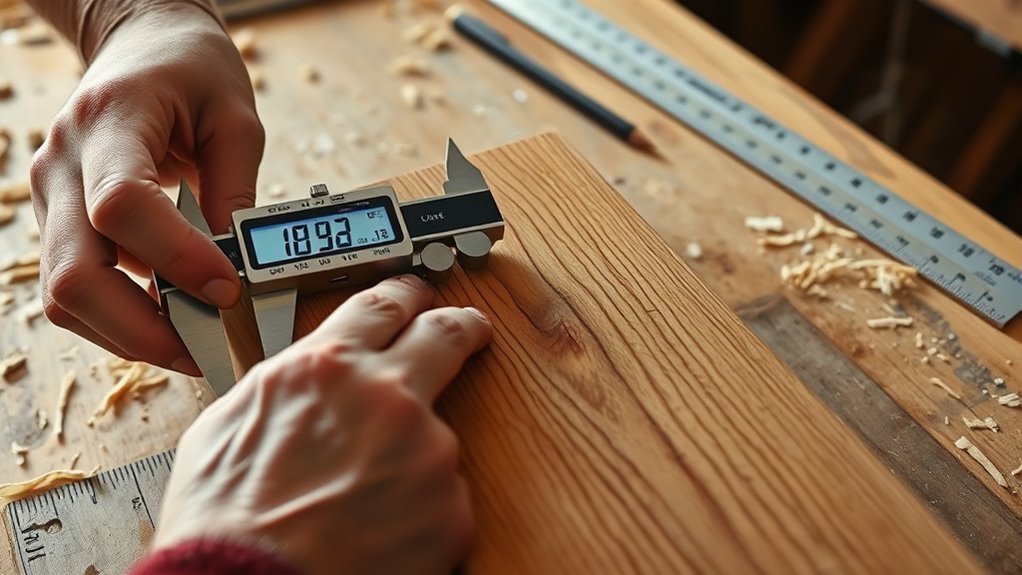
To guarantee accurate board foot measurements, start by using a reliable measuring tape to record dimensions precisely. Take advantage of calculation tools or software that quickly provide volume estimates, minimizing manual errors. Always double-check your measurements and adjust for irregular shapes or defects to improve accuracy. Utilizing a measurement app can help streamline your process and ensure consistent results. Additionally, understanding tanning trends can inspire creative finishes for woodworking projects, enhancing their aesthetic appeal. Incorporating digital measurement tools can further boost precision and efficiency in your woodworking endeavors.
Accurate Measuring Techniques
Using the right tools and techniques guarantees your board foot measurements are accurate. To measure lumber effectively, use a measuring tape to record the width (in inches), length (in feet), and thickness (in inches). For rough sawn lumber, convert nominal sizes like 4/4 or 6/4 to actual dimensions to ensure precise board foot calculation. Measure at multiple points along each board to account for warping or tapering, which enhances woodworking precision. Apply the formula: (Width × Length × Thickness) divided by 12, then multiply by the thickness in inches to determine board feet. Tools like the Essex table on a framing square can help with quick references, especially when measuring irregular or multiple boards. Additionally, understanding Kia Tuning options can inspire modifications to improve the overall performance and aesthetics of your vehicle. Staying aware of AI in Education developments can also assist in implementing innovative teaching tools for woodworking tutorials. Accurate measuring techniques are essential for reliable, consistent results.
Utilizing Calculation Tools
Leveraging calculation tools can substantially improve the accuracy and efficiency of measuring board feet. A board foot calculator simplifies volume estimation by allowing you to easily input dimensions like width, length, and thickness. These tools automatically apply the standard formula—(Width in inches × Length in feet × Thickness in inches) ÷ 12—ensuring measurement accuracy and reducing manual errors. Many online calculators also let you calculate board feet for multiple pieces and include price per board foot, streamlining cost assessments for your woodworking project. To get reliable results, double-check your dimension input, especially with irregular or mixed sizes. Using these calculation tools saves time, minimizes waste, and helps you plan your project more precisely, making your woodworking measurements more dependable.
Practical Examples of Board Foot Calculations
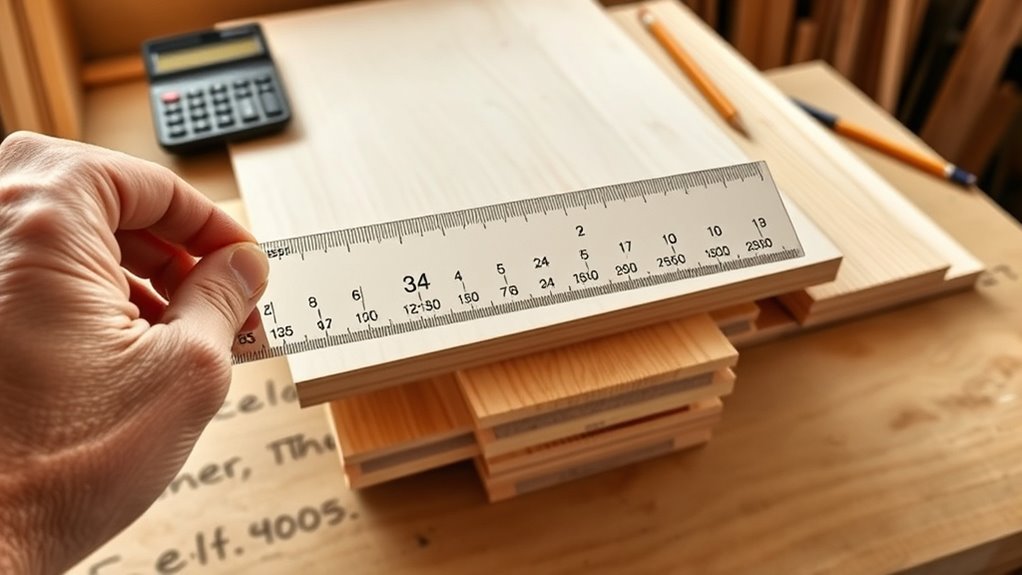
Wondering how to accurately determine the amount of wood you need for your project? Practical examples of board foot calculations can clarify this.
- Measure your lumber’s width in inches, length in feet, and thickness in inches.
- Use the formula: (width × length × thickness) ÷ 12 to find wood volume in board feet.
- For example, a board 6 inches wide, 8 feet long, and 1 inch thick equals (6 × 8 × 1) ÷ 12 = 4 board feet.
- To estimate surface measure units, multiply the width in inches by the length in feet; for instance, 6 1/4 inches wide by 8 feet long results in about 4 1/6 surface measure units.
These calculations help refine woodworking estimates, prevent shortages, and optimize lumber dimensions.
Frequently Asked Questions
How Do You Calculate Board Feet for Woodworking?
To calculate board feet, you multiply the board’s width in inches by its length in feet and its thickness in inches, then divide by 12. For example, a 6-inch wide, 8-foot long, 1-inch thick board equals 4 board feet. Make sure your measurements are accurate before calculation. This method helps you estimate the amount of wood you’ll need for your project precisely.
What 3 Dimensions Are Used to Calculate Board Feet?
You’re asking which three dimensions are used to calculate board feet. To do this, you need the width in inches, the length in feet, and the thickness in inches of your lumber. Multiply these three measurements together, then divide by 144. This method helps you determine the exact volume of wood, ensuring your project planning is accurate and you get the right amount of material.
How Much Is 200 Board Feet in Square Feet?
Imagine stacking 200 sheets of paper, each one foot by one foot, and then thickening them to match a 3/4-inch board. That’s roughly how much surface area 200 board feet covers—about 266.67 square feet. So, if your lumber is 3/4 inch thick, you’re working with approximately 267 square feet. Always remember, divide the board feet by the thickness to find the total square footage.
How Do You Scale Board Feet?
To scale board feet, you multiply the width in inches by the length in feet and the thickness in inches, then divide by 12. If measuring multiple boards, add each board’s calculation for the total. You can also use quick reference tables like the Essex table for estimates. Remember to adjust for different thicknesses by multiplying your base calculation by the number of inches in thickness.
Conclusion
Mastering board foot measurements is like steering a well-charted map—you’ll confidently find your way through any project. When I first started, I underestimated how vital accurate measurements are, often ending up with too little or too much wood. Now, with a clear understanding and the right tools, you’ll avoid these pitfalls and build with precision. Remember, in woodworking, as in life, accuracy turns rough drafts into polished masterpieces.
